Analyzing Leadership Roles, Culture, and Structure at FitFlop
VerifiedAdded on 2023/06/14
|12
|3666
|207
Report
AI Summary
This report provides an analysis of FitFlop's organizational behavior, focusing on its structure, culture, and leadership roles in the context of organizational changes. It examines the hierarchical structure and role culture adopted by FitFlop, detailing how these elements influence employee behavior and decision-making. The report also discusses the different roles a leader plays, such as identifying team goals, clarifying vision, and developing team strengths. Furthermore, it explores ways to build an effective team through motivation, applying Herzberg's two-factor theory to illustrate how motivating and hygiene factors impact employee engagement during organizational changes. The analysis identifies key team attributes based on the Belbin theory, categorizing members as thought-oriented, action-oriented, and people-oriented, highlighting their contributions to team progress and organizational success. This document is available on Desklib, a platform offering a wide range of study resources for students.
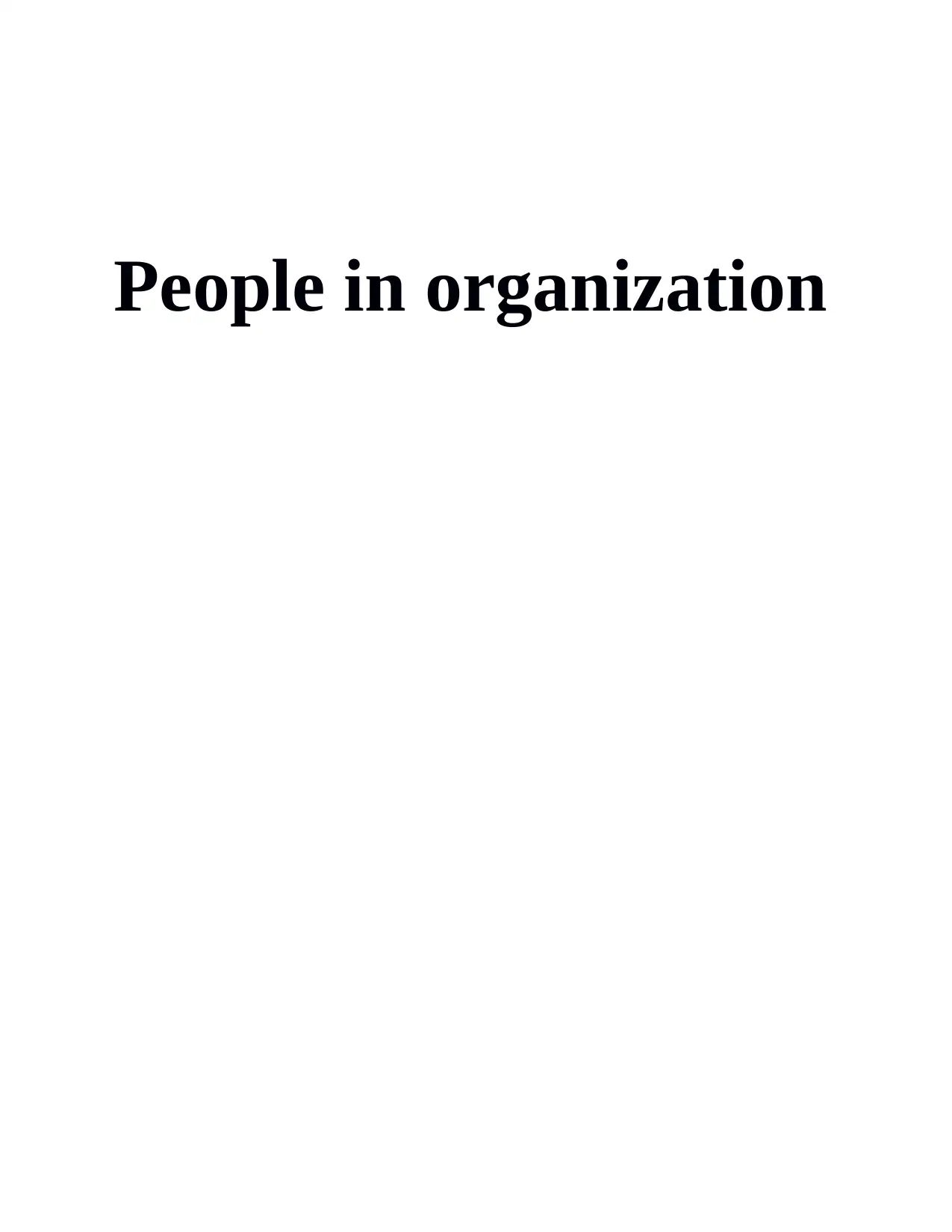
People in organization
Paraphrase This Document
Need a fresh take? Get an instant paraphrase of this document with our AI Paraphraser
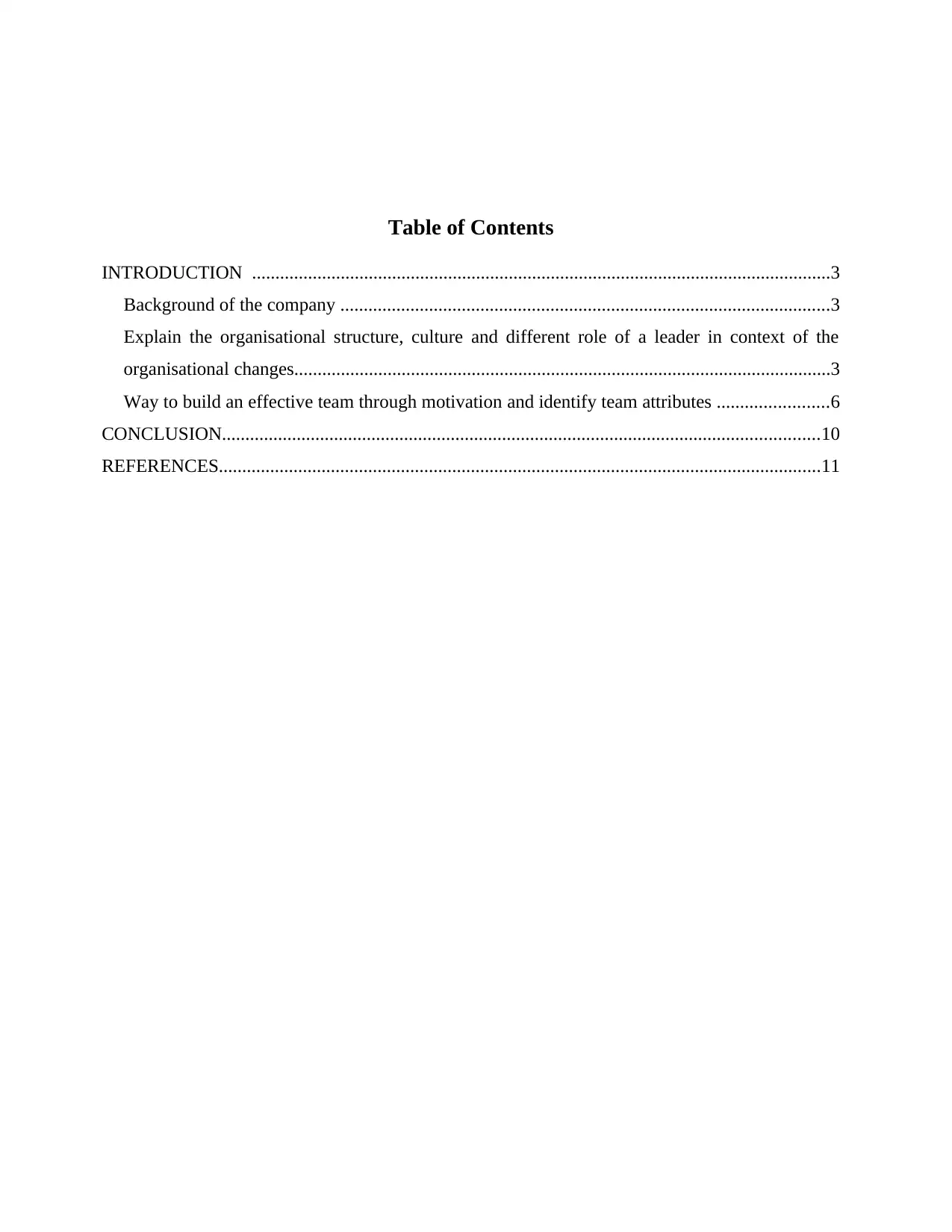
Table of Contents
INTRODUCTION ............................................................................................................................3
Background of the company .........................................................................................................3
Explain the organisational structure, culture and different role of a leader in context of the
organisational changes...................................................................................................................3
Way to build an effective team through motivation and identify team attributes ........................6
CONCLUSION................................................................................................................................10
REFERENCES.................................................................................................................................11
INTRODUCTION ............................................................................................................................3
Background of the company .........................................................................................................3
Explain the organisational structure, culture and different role of a leader in context of the
organisational changes...................................................................................................................3
Way to build an effective team through motivation and identify team attributes ........................6
CONCLUSION................................................................................................................................10
REFERENCES.................................................................................................................................11
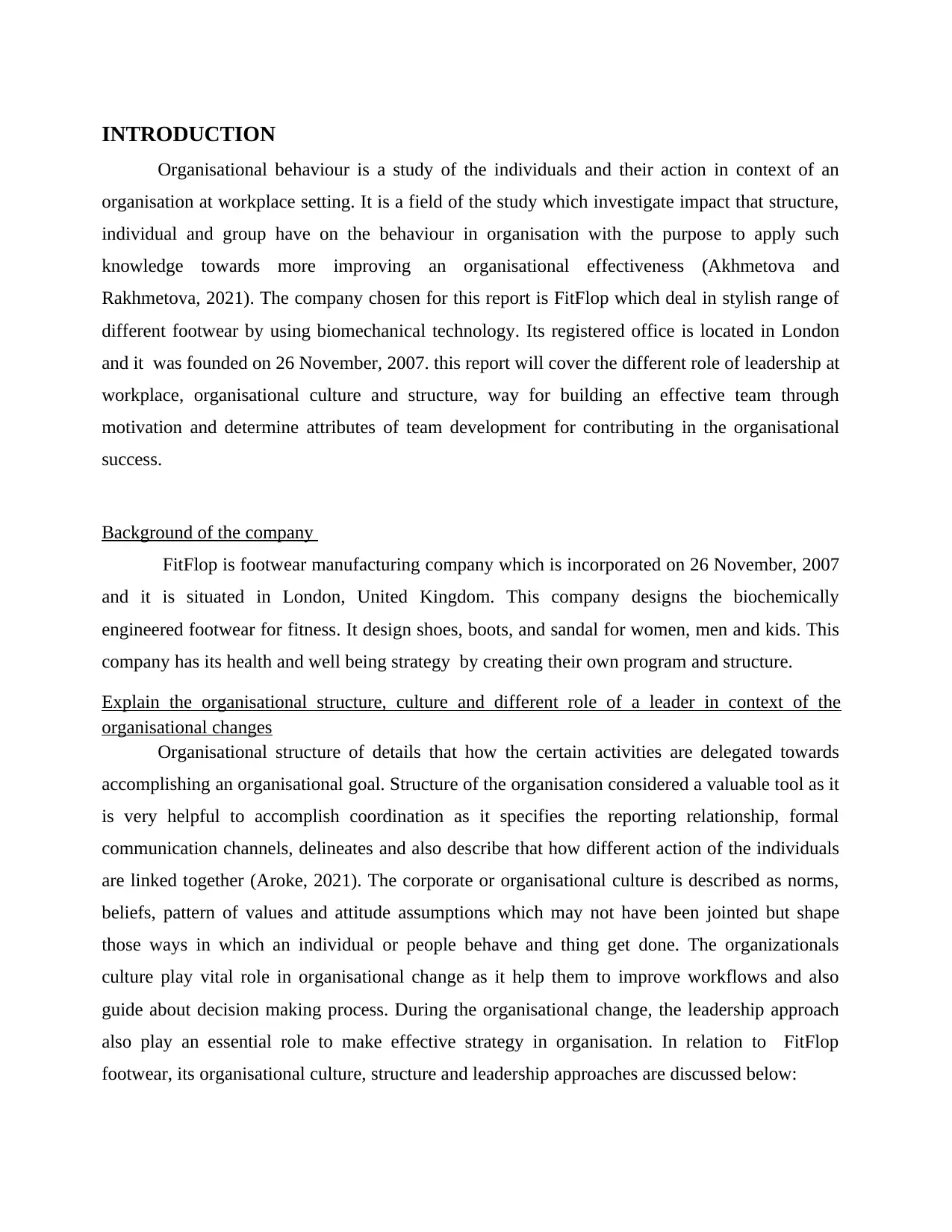
INTRODUCTION
Organisational behaviour is a study of the individuals and their action in context of an
organisation at workplace setting. It is a field of the study which investigate impact that structure,
individual and group have on the behaviour in organisation with the purpose to apply such
knowledge towards more improving an organisational effectiveness (Akhmetova and
Rakhmetova, 2021). The company chosen for this report is FitFlop which deal in stylish range of
different footwear by using biomechanical technology. Its registered office is located in London
and it was founded on 26 November, 2007. this report will cover the different role of leadership at
workplace, organisational culture and structure, way for building an effective team through
motivation and determine attributes of team development for contributing in the organisational
success.
Background of the company
FitFlop is footwear manufacturing company which is incorporated on 26 November, 2007
and it is situated in London, United Kingdom. This company designs the biochemically
engineered footwear for fitness. It design shoes, boots, and sandal for women, men and kids. This
company has its health and well being strategy by creating their own program and structure.
Explain the organisational structure, culture and different role of a leader in context of the
organisational changes
Organisational structure of details that how the certain activities are delegated towards
accomplishing an organisational goal. Structure of the organisation considered a valuable tool as it
is very helpful to accomplish coordination as it specifies the reporting relationship, formal
communication channels, delineates and also describe that how different action of the individuals
are linked together (Aroke, 2021). The corporate or organisational culture is described as norms,
beliefs, pattern of values and attitude assumptions which may not have been jointed but shape
those ways in which an individual or people behave and thing get done. The organizationals
culture play vital role in organisational change as it help them to improve workflows and also
guide about decision making process. During the organisational change, the leadership approach
also play an essential role to make effective strategy in organisation. In relation to FitFlop
footwear, its organisational culture, structure and leadership approaches are discussed below:
Organisational behaviour is a study of the individuals and their action in context of an
organisation at workplace setting. It is a field of the study which investigate impact that structure,
individual and group have on the behaviour in organisation with the purpose to apply such
knowledge towards more improving an organisational effectiveness (Akhmetova and
Rakhmetova, 2021). The company chosen for this report is FitFlop which deal in stylish range of
different footwear by using biomechanical technology. Its registered office is located in London
and it was founded on 26 November, 2007. this report will cover the different role of leadership at
workplace, organisational culture and structure, way for building an effective team through
motivation and determine attributes of team development for contributing in the organisational
success.
Background of the company
FitFlop is footwear manufacturing company which is incorporated on 26 November, 2007
and it is situated in London, United Kingdom. This company designs the biochemically
engineered footwear for fitness. It design shoes, boots, and sandal for women, men and kids. This
company has its health and well being strategy by creating their own program and structure.
Explain the organisational structure, culture and different role of a leader in context of the
organisational changes
Organisational structure of details that how the certain activities are delegated towards
accomplishing an organisational goal. Structure of the organisation considered a valuable tool as it
is very helpful to accomplish coordination as it specifies the reporting relationship, formal
communication channels, delineates and also describe that how different action of the individuals
are linked together (Aroke, 2021). The corporate or organisational culture is described as norms,
beliefs, pattern of values and attitude assumptions which may not have been jointed but shape
those ways in which an individual or people behave and thing get done. The organizationals
culture play vital role in organisational change as it help them to improve workflows and also
guide about decision making process. During the organisational change, the leadership approach
also play an essential role to make effective strategy in organisation. In relation to FitFlop
footwear, its organisational culture, structure and leadership approaches are discussed below:
⊘ This is a preview!⊘
Do you want full access?
Subscribe today to unlock all pages.

Trusted by 1+ million students worldwide
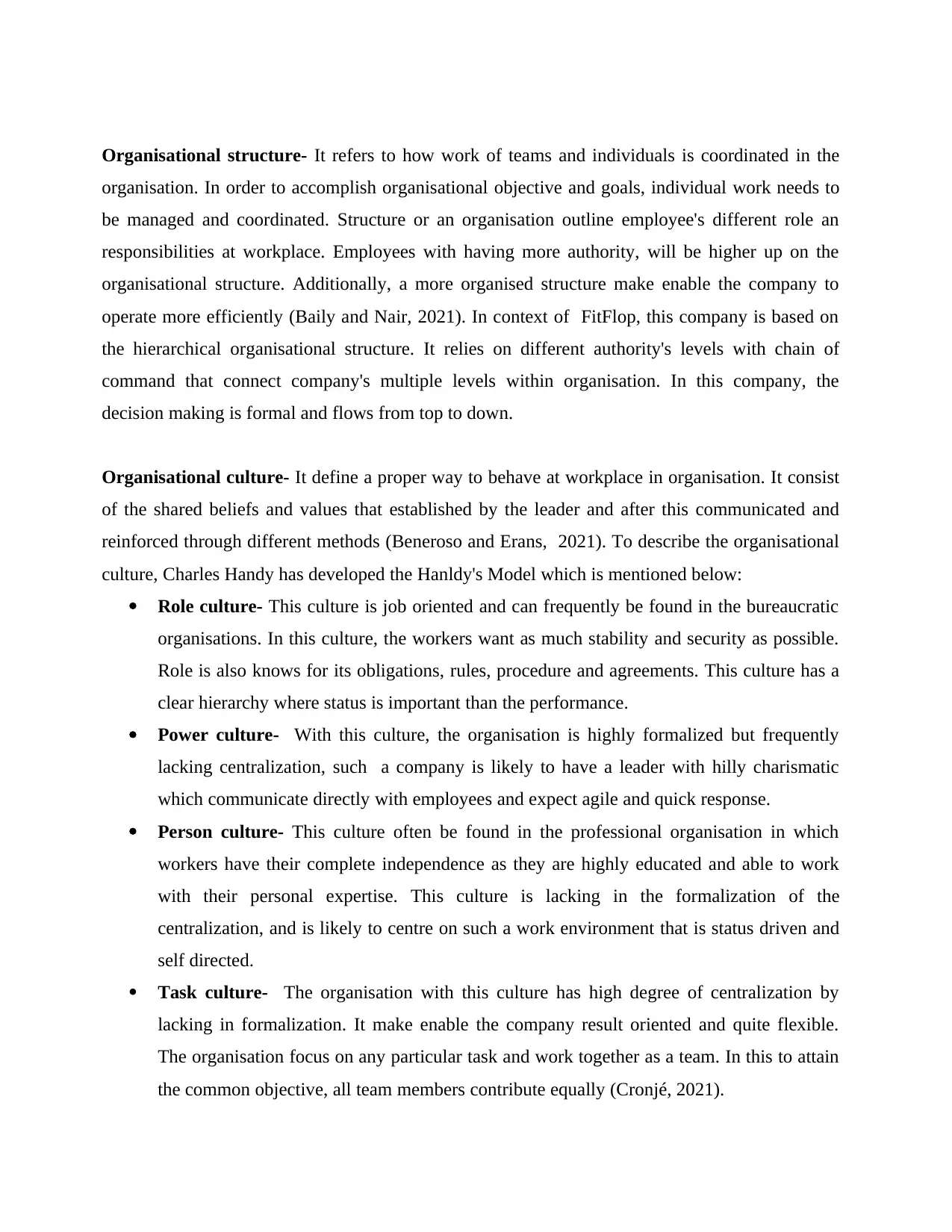
Organisational structure- It refers to how work of teams and individuals is coordinated in the
organisation. In order to accomplish organisational objective and goals, individual work needs to
be managed and coordinated. Structure or an organisation outline employee's different role an
responsibilities at workplace. Employees with having more authority, will be higher up on the
organisational structure. Additionally, a more organised structure make enable the company to
operate more efficiently (Baily and Nair, 2021). In context of FitFlop, this company is based on
the hierarchical organisational structure. It relies on different authority's levels with chain of
command that connect company's multiple levels within organisation. In this company, the
decision making is formal and flows from top to down.
Organisational culture- It define a proper way to behave at workplace in organisation. It consist
of the shared beliefs and values that established by the leader and after this communicated and
reinforced through different methods (Beneroso and Erans, 2021). To describe the organisational
culture, Charles Handy has developed the Hanldy's Model which is mentioned below:
Role culture- This culture is job oriented and can frequently be found in the bureaucratic
organisations. In this culture, the workers want as much stability and security as possible.
Role is also knows for its obligations, rules, procedure and agreements. This culture has a
clear hierarchy where status is important than the performance.
Power culture- With this culture, the organisation is highly formalized but frequently
lacking centralization, such a company is likely to have a leader with hilly charismatic
which communicate directly with employees and expect agile and quick response.
Person culture- This culture often be found in the professional organisation in which
workers have their complete independence as they are highly educated and able to work
with their personal expertise. This culture is lacking in the formalization of the
centralization, and is likely to centre on such a work environment that is status driven and
self directed.
Task culture- The organisation with this culture has high degree of centralization by
lacking in formalization. It make enable the company result oriented and quite flexible.
The organisation focus on any particular task and work together as a team. In this to attain
the common objective, all team members contribute equally (Cronjé, 2021).
organisation. In order to accomplish organisational objective and goals, individual work needs to
be managed and coordinated. Structure or an organisation outline employee's different role an
responsibilities at workplace. Employees with having more authority, will be higher up on the
organisational structure. Additionally, a more organised structure make enable the company to
operate more efficiently (Baily and Nair, 2021). In context of FitFlop, this company is based on
the hierarchical organisational structure. It relies on different authority's levels with chain of
command that connect company's multiple levels within organisation. In this company, the
decision making is formal and flows from top to down.
Organisational culture- It define a proper way to behave at workplace in organisation. It consist
of the shared beliefs and values that established by the leader and after this communicated and
reinforced through different methods (Beneroso and Erans, 2021). To describe the organisational
culture, Charles Handy has developed the Hanldy's Model which is mentioned below:
Role culture- This culture is job oriented and can frequently be found in the bureaucratic
organisations. In this culture, the workers want as much stability and security as possible.
Role is also knows for its obligations, rules, procedure and agreements. This culture has a
clear hierarchy where status is important than the performance.
Power culture- With this culture, the organisation is highly formalized but frequently
lacking centralization, such a company is likely to have a leader with hilly charismatic
which communicate directly with employees and expect agile and quick response.
Person culture- This culture often be found in the professional organisation in which
workers have their complete independence as they are highly educated and able to work
with their personal expertise. This culture is lacking in the formalization of the
centralization, and is likely to centre on such a work environment that is status driven and
self directed.
Task culture- The organisation with this culture has high degree of centralization by
lacking in formalization. It make enable the company result oriented and quite flexible.
The organisation focus on any particular task and work together as a team. In this to attain
the common objective, all team members contribute equally (Cronjé, 2021).
Paraphrase This Document
Need a fresh take? Get an instant paraphrase of this document with our AI Paraphraser
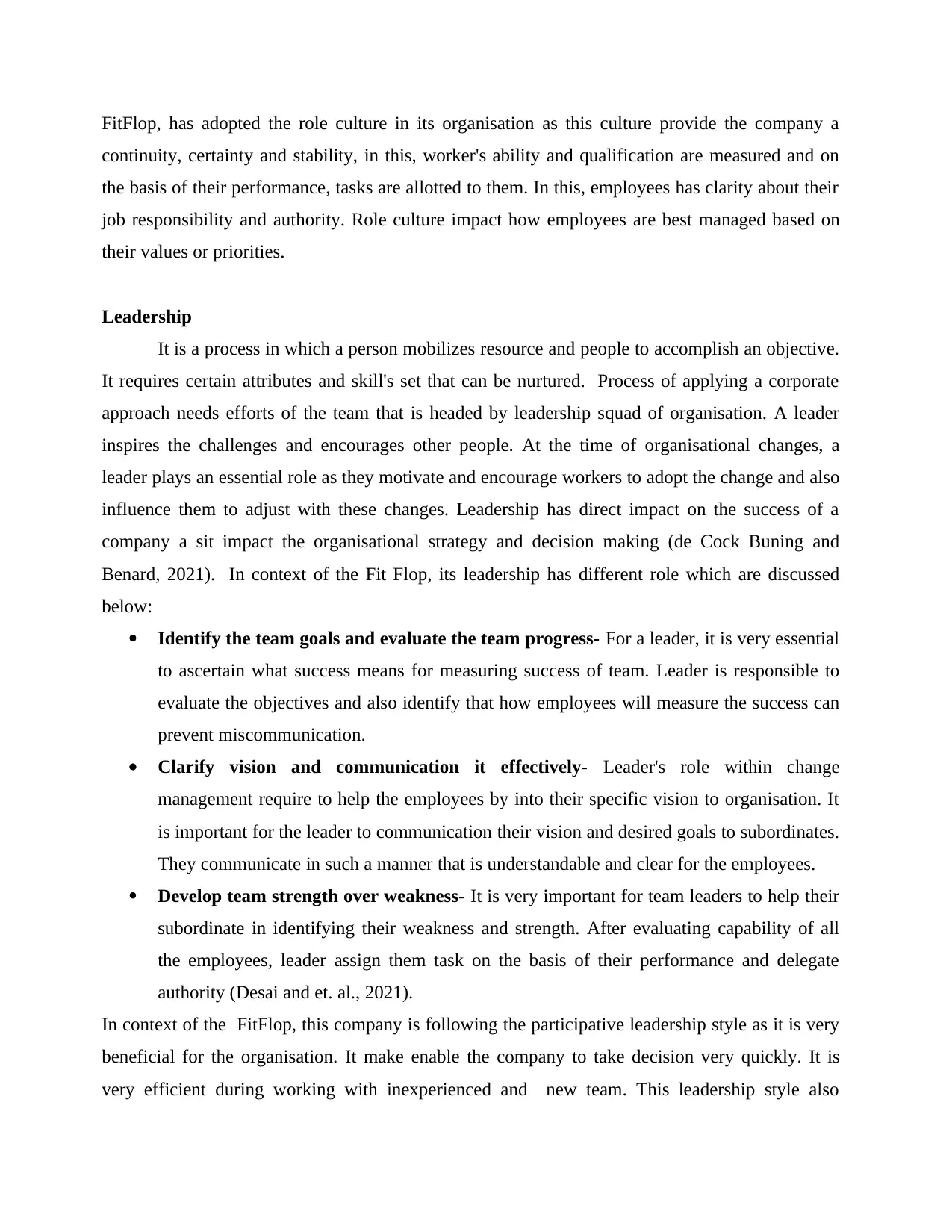
FitFlop, has adopted the role culture in its organisation as this culture provide the company a
continuity, certainty and stability, in this, worker's ability and qualification are measured and on
the basis of their performance, tasks are allotted to them. In this, employees has clarity about their
job responsibility and authority. Role culture impact how employees are best managed based on
their values or priorities.
Leadership
It is a process in which a person mobilizes resource and people to accomplish an objective.
It requires certain attributes and skill's set that can be nurtured. Process of applying a corporate
approach needs efforts of the team that is headed by leadership squad of organisation. A leader
inspires the challenges and encourages other people. At the time of organisational changes, a
leader plays an essential role as they motivate and encourage workers to adopt the change and also
influence them to adjust with these changes. Leadership has direct impact on the success of a
company a sit impact the organisational strategy and decision making (de Cock Buning and
Benard, 2021). In context of the Fit Flop, its leadership has different role which are discussed
below:
Identify the team goals and evaluate the team progress- For a leader, it is very essential
to ascertain what success means for measuring success of team. Leader is responsible to
evaluate the objectives and also identify that how employees will measure the success can
prevent miscommunication.
Clarify vision and communication it effectively- Leader's role within change
management require to help the employees by into their specific vision to organisation. It
is important for the leader to communication their vision and desired goals to subordinates.
They communicate in such a manner that is understandable and clear for the employees.
Develop team strength over weakness- It is very important for team leaders to help their
subordinate in identifying their weakness and strength. After evaluating capability of all
the employees, leader assign them task on the basis of their performance and delegate
authority (Desai and et. al., 2021).
In context of the FitFlop, this company is following the participative leadership style as it is very
beneficial for the organisation. It make enable the company to take decision very quickly. It is
very efficient during working with inexperienced and new team. This leadership style also
continuity, certainty and stability, in this, worker's ability and qualification are measured and on
the basis of their performance, tasks are allotted to them. In this, employees has clarity about their
job responsibility and authority. Role culture impact how employees are best managed based on
their values or priorities.
Leadership
It is a process in which a person mobilizes resource and people to accomplish an objective.
It requires certain attributes and skill's set that can be nurtured. Process of applying a corporate
approach needs efforts of the team that is headed by leadership squad of organisation. A leader
inspires the challenges and encourages other people. At the time of organisational changes, a
leader plays an essential role as they motivate and encourage workers to adopt the change and also
influence them to adjust with these changes. Leadership has direct impact on the success of a
company a sit impact the organisational strategy and decision making (de Cock Buning and
Benard, 2021). In context of the Fit Flop, its leadership has different role which are discussed
below:
Identify the team goals and evaluate the team progress- For a leader, it is very essential
to ascertain what success means for measuring success of team. Leader is responsible to
evaluate the objectives and also identify that how employees will measure the success can
prevent miscommunication.
Clarify vision and communication it effectively- Leader's role within change
management require to help the employees by into their specific vision to organisation. It
is important for the leader to communication their vision and desired goals to subordinates.
They communicate in such a manner that is understandable and clear for the employees.
Develop team strength over weakness- It is very important for team leaders to help their
subordinate in identifying their weakness and strength. After evaluating capability of all
the employees, leader assign them task on the basis of their performance and delegate
authority (Desai and et. al., 2021).
In context of the FitFlop, this company is following the participative leadership style as it is very
beneficial for the organisation. It make enable the company to take decision very quickly. It is
very efficient during working with inexperienced and new team. This leadership style also
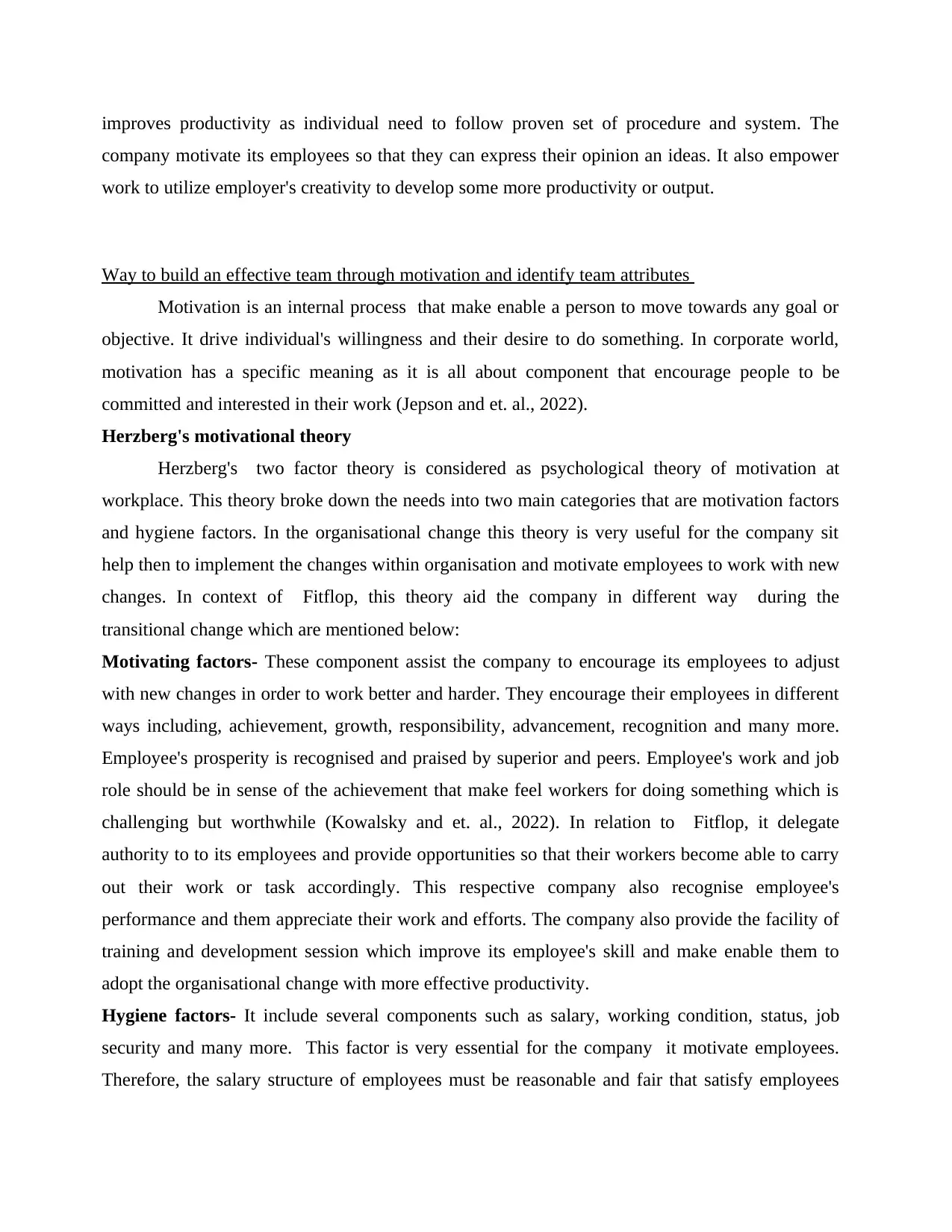
improves productivity as individual need to follow proven set of procedure and system. The
company motivate its employees so that they can express their opinion an ideas. It also empower
work to utilize employer's creativity to develop some more productivity or output.
Way to build an effective team through motivation and identify team attributes
Motivation is an internal process that make enable a person to move towards any goal or
objective. It drive individual's willingness and their desire to do something. In corporate world,
motivation has a specific meaning as it is all about component that encourage people to be
committed and interested in their work (Jepson and et. al., 2022).
Herzberg's motivational theory
Herzberg's two factor theory is considered as psychological theory of motivation at
workplace. This theory broke down the needs into two main categories that are motivation factors
and hygiene factors. In the organisational change this theory is very useful for the company sit
help then to implement the changes within organisation and motivate employees to work with new
changes. In context of Fitflop, this theory aid the company in different way during the
transitional change which are mentioned below:
Motivating factors- These component assist the company to encourage its employees to adjust
with new changes in order to work better and harder. They encourage their employees in different
ways including, achievement, growth, responsibility, advancement, recognition and many more.
Employee's prosperity is recognised and praised by superior and peers. Employee's work and job
role should be in sense of the achievement that make feel workers for doing something which is
challenging but worthwhile (Kowalsky and et. al., 2022). In relation to Fitflop, it delegate
authority to to its employees and provide opportunities so that their workers become able to carry
out their work or task accordingly. This respective company also recognise employee's
performance and them appreciate their work and efforts. The company also provide the facility of
training and development session which improve its employee's skill and make enable them to
adopt the organisational change with more effective productivity.
Hygiene factors- It include several components such as salary, working condition, status, job
security and many more. This factor is very essential for the company it motivate employees.
Therefore, the salary structure of employees must be reasonable and fair that satisfy employees
company motivate its employees so that they can express their opinion an ideas. It also empower
work to utilize employer's creativity to develop some more productivity or output.
Way to build an effective team through motivation and identify team attributes
Motivation is an internal process that make enable a person to move towards any goal or
objective. It drive individual's willingness and their desire to do something. In corporate world,
motivation has a specific meaning as it is all about component that encourage people to be
committed and interested in their work (Jepson and et. al., 2022).
Herzberg's motivational theory
Herzberg's two factor theory is considered as psychological theory of motivation at
workplace. This theory broke down the needs into two main categories that are motivation factors
and hygiene factors. In the organisational change this theory is very useful for the company sit
help then to implement the changes within organisation and motivate employees to work with new
changes. In context of Fitflop, this theory aid the company in different way during the
transitional change which are mentioned below:
Motivating factors- These component assist the company to encourage its employees to adjust
with new changes in order to work better and harder. They encourage their employees in different
ways including, achievement, growth, responsibility, advancement, recognition and many more.
Employee's prosperity is recognised and praised by superior and peers. Employee's work and job
role should be in sense of the achievement that make feel workers for doing something which is
challenging but worthwhile (Kowalsky and et. al., 2022). In relation to Fitflop, it delegate
authority to to its employees and provide opportunities so that their workers become able to carry
out their work or task accordingly. This respective company also recognise employee's
performance and them appreciate their work and efforts. The company also provide the facility of
training and development session which improve its employee's skill and make enable them to
adopt the organisational change with more effective productivity.
Hygiene factors- It include several components such as salary, working condition, status, job
security and many more. This factor is very essential for the company it motivate employees.
Therefore, the salary structure of employees must be reasonable and fair that satisfy employees
⊘ This is a preview!⊘
Do you want full access?
Subscribe today to unlock all pages.

Trusted by 1+ million students worldwide
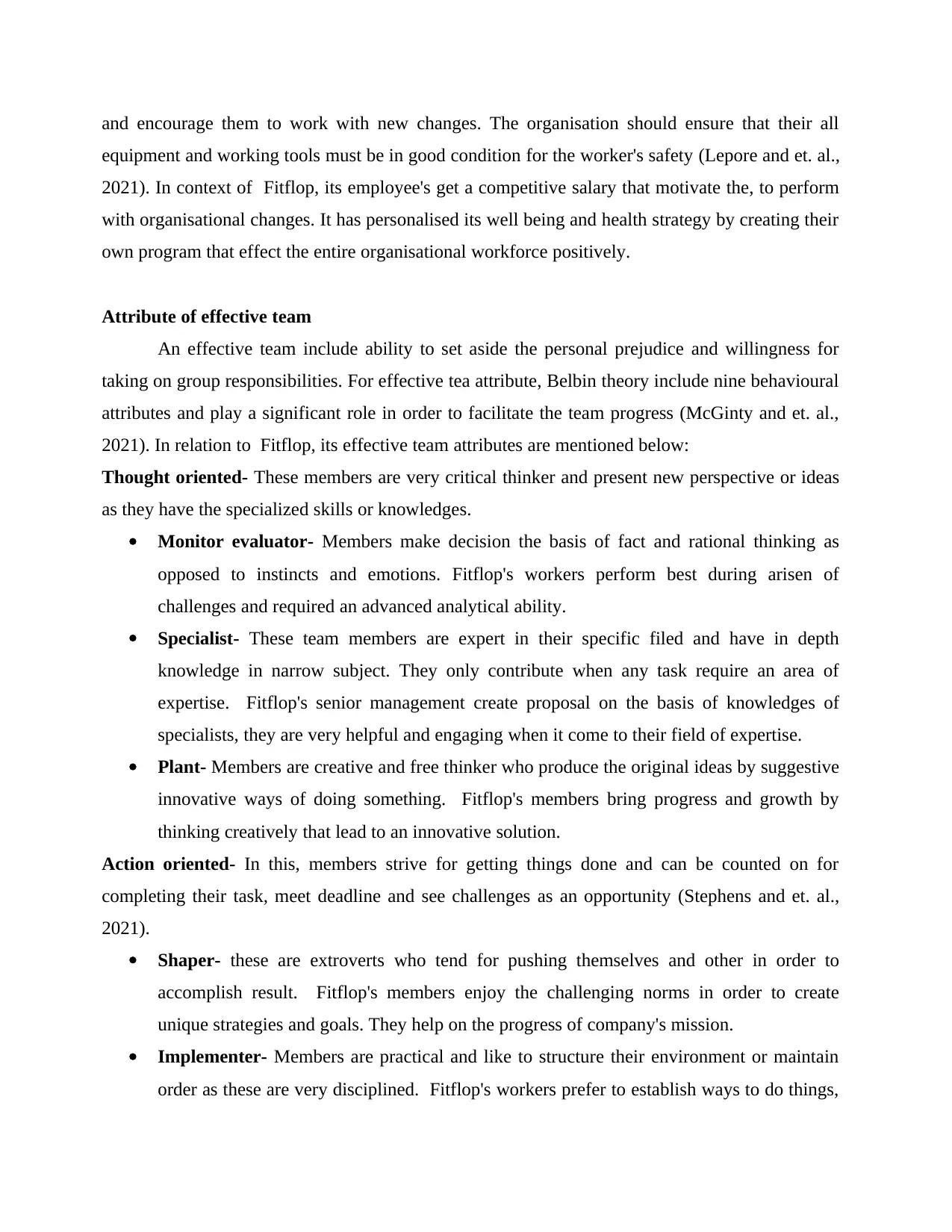
and encourage them to work with new changes. The organisation should ensure that their all
equipment and working tools must be in good condition for the worker's safety (Lepore and et. al.,
2021). In context of Fitflop, its employee's get a competitive salary that motivate the, to perform
with organisational changes. It has personalised its well being and health strategy by creating their
own program that effect the entire organisational workforce positively.
Attribute of effective team
An effective team include ability to set aside the personal prejudice and willingness for
taking on group responsibilities. For effective tea attribute, Belbin theory include nine behavioural
attributes and play a significant role in order to facilitate the team progress (McGinty and et. al.,
2021). In relation to Fitflop, its effective team attributes are mentioned below:
Thought oriented- These members are very critical thinker and present new perspective or ideas
as they have the specialized skills or knowledges.
Monitor evaluator- Members make decision the basis of fact and rational thinking as
opposed to instincts and emotions. Fitflop's workers perform best during arisen of
challenges and required an advanced analytical ability.
Specialist- These team members are expert in their specific filed and have in depth
knowledge in narrow subject. They only contribute when any task require an area of
expertise. Fitflop's senior management create proposal on the basis of knowledges of
specialists, they are very helpful and engaging when it come to their field of expertise.
Plant- Members are creative and free thinker who produce the original ideas by suggestive
innovative ways of doing something. Fitflop's members bring progress and growth by
thinking creatively that lead to an innovative solution.
Action oriented- In this, members strive for getting things done and can be counted on for
completing their task, meet deadline and see challenges as an opportunity (Stephens and et. al.,
2021).
Shaper- these are extroverts who tend for pushing themselves and other in order to
accomplish result. Fitflop's members enjoy the challenging norms in order to create
unique strategies and goals. They help on the progress of company's mission.
Implementer- Members are practical and like to structure their environment or maintain
order as these are very disciplined. Fitflop's workers prefer to establish ways to do things,
equipment and working tools must be in good condition for the worker's safety (Lepore and et. al.,
2021). In context of Fitflop, its employee's get a competitive salary that motivate the, to perform
with organisational changes. It has personalised its well being and health strategy by creating their
own program that effect the entire organisational workforce positively.
Attribute of effective team
An effective team include ability to set aside the personal prejudice and willingness for
taking on group responsibilities. For effective tea attribute, Belbin theory include nine behavioural
attributes and play a significant role in order to facilitate the team progress (McGinty and et. al.,
2021). In relation to Fitflop, its effective team attributes are mentioned below:
Thought oriented- These members are very critical thinker and present new perspective or ideas
as they have the specialized skills or knowledges.
Monitor evaluator- Members make decision the basis of fact and rational thinking as
opposed to instincts and emotions. Fitflop's workers perform best during arisen of
challenges and required an advanced analytical ability.
Specialist- These team members are expert in their specific filed and have in depth
knowledge in narrow subject. They only contribute when any task require an area of
expertise. Fitflop's senior management create proposal on the basis of knowledges of
specialists, they are very helpful and engaging when it come to their field of expertise.
Plant- Members are creative and free thinker who produce the original ideas by suggestive
innovative ways of doing something. Fitflop's members bring progress and growth by
thinking creatively that lead to an innovative solution.
Action oriented- In this, members strive for getting things done and can be counted on for
completing their task, meet deadline and see challenges as an opportunity (Stephens and et. al.,
2021).
Shaper- these are extroverts who tend for pushing themselves and other in order to
accomplish result. Fitflop's members enjoy the challenging norms in order to create
unique strategies and goals. They help on the progress of company's mission.
Implementer- Members are practical and like to structure their environment or maintain
order as these are very disciplined. Fitflop's workers prefer to establish ways to do things,
Paraphrase This Document
Need a fresh take? Get an instant paraphrase of this document with our AI Paraphraser
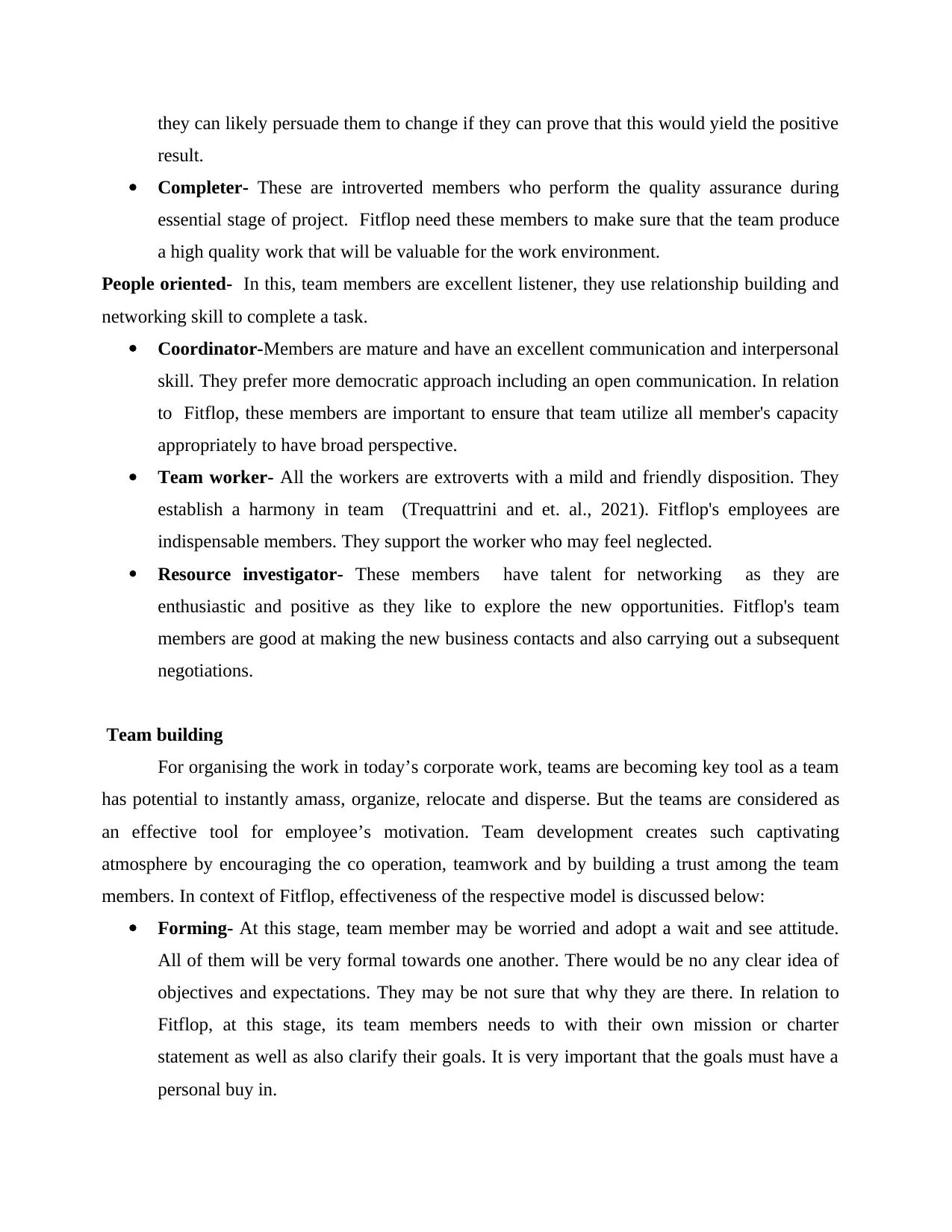
they can likely persuade them to change if they can prove that this would yield the positive
result.
Completer- These are introverted members who perform the quality assurance during
essential stage of project. Fitflop need these members to make sure that the team produce
a high quality work that will be valuable for the work environment.
People oriented- In this, team members are excellent listener, they use relationship building and
networking skill to complete a task.
Coordinator-Members are mature and have an excellent communication and interpersonal
skill. They prefer more democratic approach including an open communication. In relation
to Fitflop, these members are important to ensure that team utilize all member's capacity
appropriately to have broad perspective.
Team worker- All the workers are extroverts with a mild and friendly disposition. They
establish a harmony in team (Trequattrini and et. al., 2021). Fitflop's employees are
indispensable members. They support the worker who may feel neglected.
Resource investigator- These members have talent for networking as they are
enthusiastic and positive as they like to explore the new opportunities. Fitflop's team
members are good at making the new business contacts and also carrying out a subsequent
negotiations.
Team building
For organising the work in today’s corporate work, teams are becoming key tool as a team
has potential to instantly amass, organize, relocate and disperse. But the teams are considered as
an effective tool for employee’s motivation. Team development creates such captivating
atmosphere by encouraging the co operation, teamwork and by building a trust among the team
members. In context of Fitflop, effectiveness of the respective model is discussed below:
Forming- At this stage, team member may be worried and adopt a wait and see attitude.
All of them will be very formal towards one another. There would be no any clear idea of
objectives and expectations. They may be not sure that why they are there. In relation to
Fitflop, at this stage, its team members needs to with their own mission or charter
statement as well as also clarify their goals. It is very important that the goals must have a
personal buy in.
result.
Completer- These are introverted members who perform the quality assurance during
essential stage of project. Fitflop need these members to make sure that the team produce
a high quality work that will be valuable for the work environment.
People oriented- In this, team members are excellent listener, they use relationship building and
networking skill to complete a task.
Coordinator-Members are mature and have an excellent communication and interpersonal
skill. They prefer more democratic approach including an open communication. In relation
to Fitflop, these members are important to ensure that team utilize all member's capacity
appropriately to have broad perspective.
Team worker- All the workers are extroverts with a mild and friendly disposition. They
establish a harmony in team (Trequattrini and et. al., 2021). Fitflop's employees are
indispensable members. They support the worker who may feel neglected.
Resource investigator- These members have talent for networking as they are
enthusiastic and positive as they like to explore the new opportunities. Fitflop's team
members are good at making the new business contacts and also carrying out a subsequent
negotiations.
Team building
For organising the work in today’s corporate work, teams are becoming key tool as a team
has potential to instantly amass, organize, relocate and disperse. But the teams are considered as
an effective tool for employee’s motivation. Team development creates such captivating
atmosphere by encouraging the co operation, teamwork and by building a trust among the team
members. In context of Fitflop, effectiveness of the respective model is discussed below:
Forming- At this stage, team member may be worried and adopt a wait and see attitude.
All of them will be very formal towards one another. There would be no any clear idea of
objectives and expectations. They may be not sure that why they are there. In relation to
Fitflop, at this stage, its team members needs to with their own mission or charter
statement as well as also clarify their goals. It is very important that the goals must have a
personal buy in.
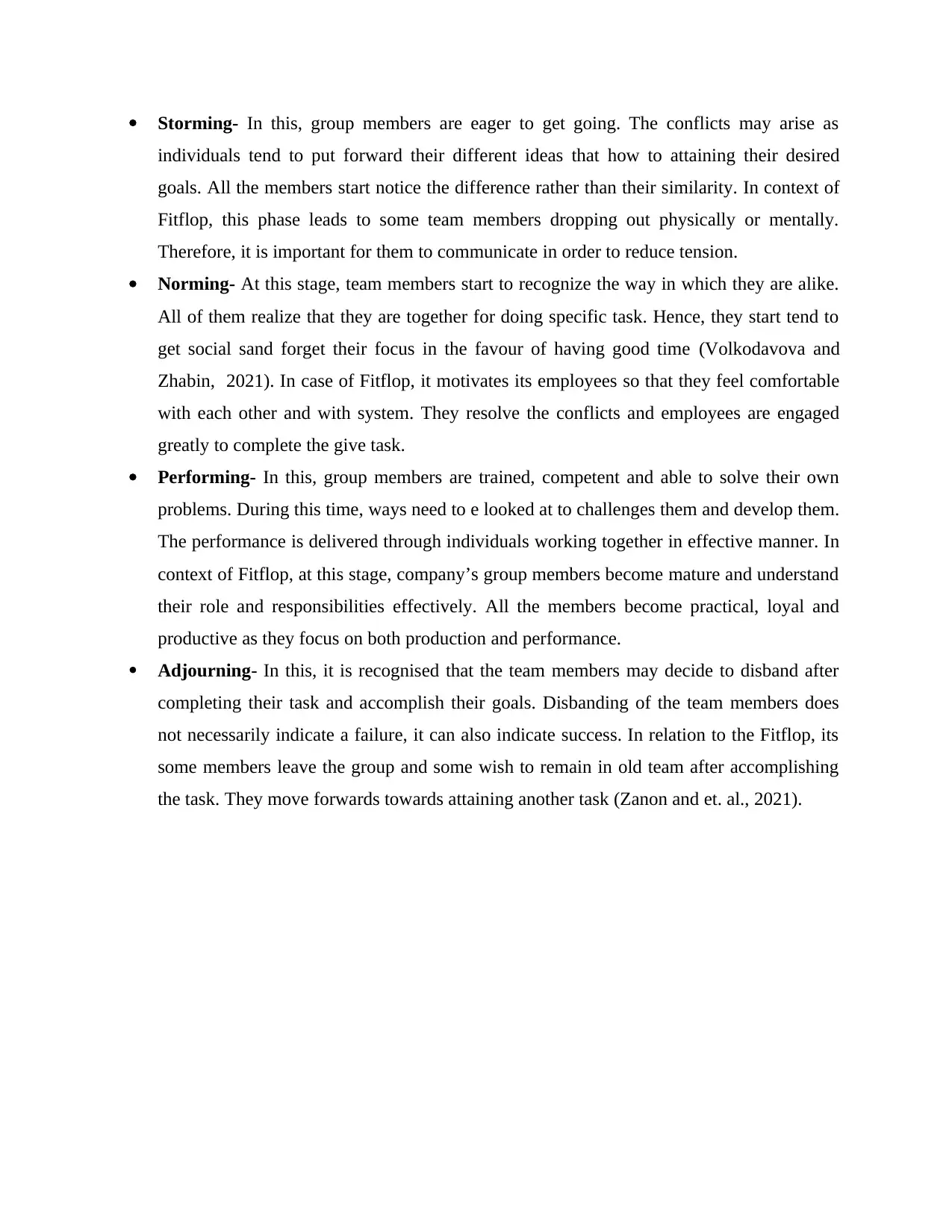
Storming- In this, group members are eager to get going. The conflicts may arise as
individuals tend to put forward their different ideas that how to attaining their desired
goals. All the members start notice the difference rather than their similarity. In context of
Fitflop, this phase leads to some team members dropping out physically or mentally.
Therefore, it is important for them to communicate in order to reduce tension.
Norming- At this stage, team members start to recognize the way in which they are alike.
All of them realize that they are together for doing specific task. Hence, they start tend to
get social sand forget their focus in the favour of having good time (Volkodavova and
Zhabin, 2021). In case of Fitflop, it motivates its employees so that they feel comfortable
with each other and with system. They resolve the conflicts and employees are engaged
greatly to complete the give task.
Performing- In this, group members are trained, competent and able to solve their own
problems. During this time, ways need to e looked at to challenges them and develop them.
The performance is delivered through individuals working together in effective manner. In
context of Fitflop, at this stage, company’s group members become mature and understand
their role and responsibilities effectively. All the members become practical, loyal and
productive as they focus on both production and performance.
Adjourning- In this, it is recognised that the team members may decide to disband after
completing their task and accomplish their goals. Disbanding of the team members does
not necessarily indicate a failure, it can also indicate success. In relation to the Fitflop, its
some members leave the group and some wish to remain in old team after accomplishing
the task. They move forwards towards attaining another task (Zanon and et. al., 2021).
individuals tend to put forward their different ideas that how to attaining their desired
goals. All the members start notice the difference rather than their similarity. In context of
Fitflop, this phase leads to some team members dropping out physically or mentally.
Therefore, it is important for them to communicate in order to reduce tension.
Norming- At this stage, team members start to recognize the way in which they are alike.
All of them realize that they are together for doing specific task. Hence, they start tend to
get social sand forget their focus in the favour of having good time (Volkodavova and
Zhabin, 2021). In case of Fitflop, it motivates its employees so that they feel comfortable
with each other and with system. They resolve the conflicts and employees are engaged
greatly to complete the give task.
Performing- In this, group members are trained, competent and able to solve their own
problems. During this time, ways need to e looked at to challenges them and develop them.
The performance is delivered through individuals working together in effective manner. In
context of Fitflop, at this stage, company’s group members become mature and understand
their role and responsibilities effectively. All the members become practical, loyal and
productive as they focus on both production and performance.
Adjourning- In this, it is recognised that the team members may decide to disband after
completing their task and accomplish their goals. Disbanding of the team members does
not necessarily indicate a failure, it can also indicate success. In relation to the Fitflop, its
some members leave the group and some wish to remain in old team after accomplishing
the task. They move forwards towards attaining another task (Zanon and et. al., 2021).
⊘ This is a preview!⊘
Do you want full access?
Subscribe today to unlock all pages.

Trusted by 1+ million students worldwide
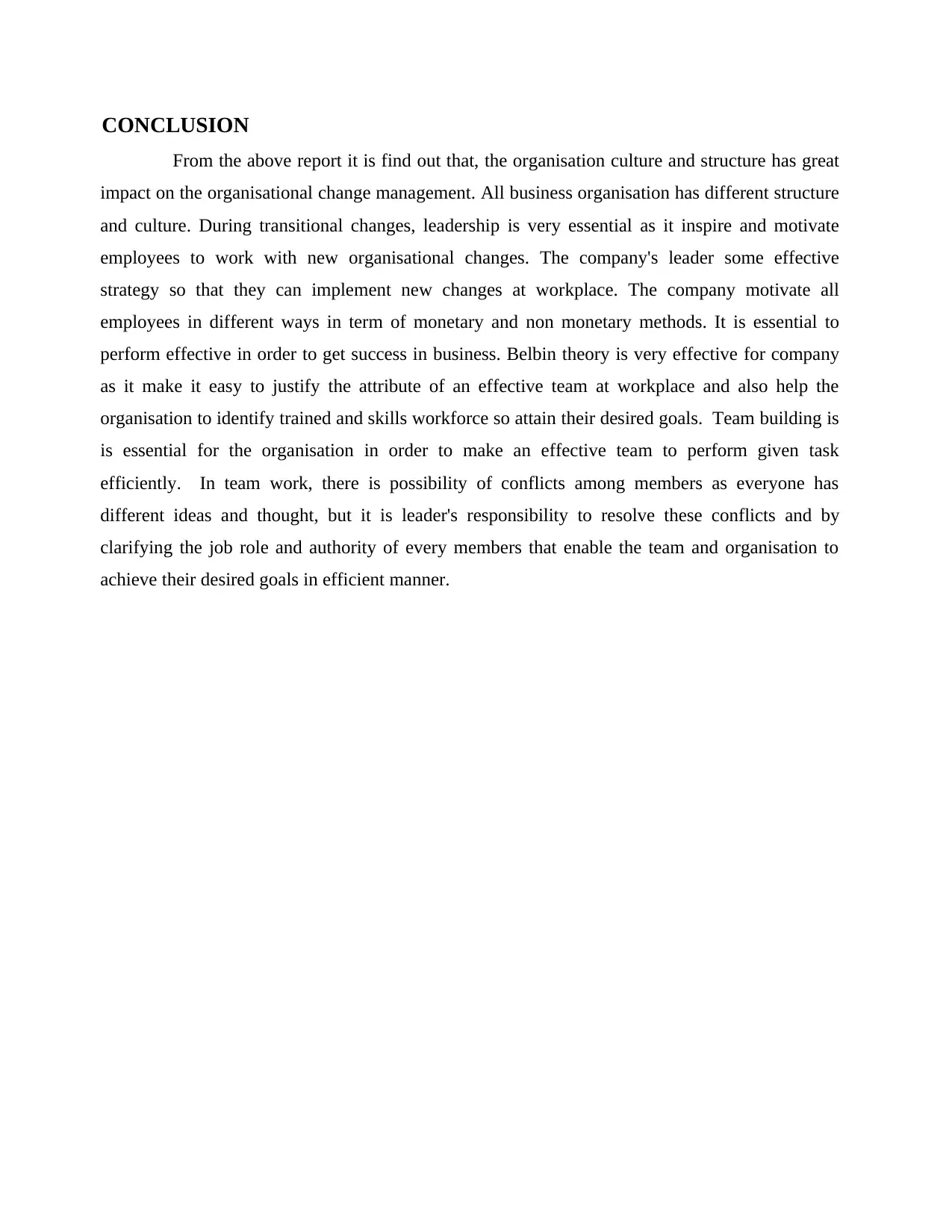
CONCLUSION
From the above report it is find out that, the organisation culture and structure has great
impact on the organisational change management. All business organisation has different structure
and culture. During transitional changes, leadership is very essential as it inspire and motivate
employees to work with new organisational changes. The company's leader some effective
strategy so that they can implement new changes at workplace. The company motivate all
employees in different ways in term of monetary and non monetary methods. It is essential to
perform effective in order to get success in business. Belbin theory is very effective for company
as it make it easy to justify the attribute of an effective team at workplace and also help the
organisation to identify trained and skills workforce so attain their desired goals. Team building is
is essential for the organisation in order to make an effective team to perform given task
efficiently. In team work, there is possibility of conflicts among members as everyone has
different ideas and thought, but it is leader's responsibility to resolve these conflicts and by
clarifying the job role and authority of every members that enable the team and organisation to
achieve their desired goals in efficient manner.
From the above report it is find out that, the organisation culture and structure has great
impact on the organisational change management. All business organisation has different structure
and culture. During transitional changes, leadership is very essential as it inspire and motivate
employees to work with new organisational changes. The company's leader some effective
strategy so that they can implement new changes at workplace. The company motivate all
employees in different ways in term of monetary and non monetary methods. It is essential to
perform effective in order to get success in business. Belbin theory is very effective for company
as it make it easy to justify the attribute of an effective team at workplace and also help the
organisation to identify trained and skills workforce so attain their desired goals. Team building is
is essential for the organisation in order to make an effective team to perform given task
efficiently. In team work, there is possibility of conflicts among members as everyone has
different ideas and thought, but it is leader's responsibility to resolve these conflicts and by
clarifying the job role and authority of every members that enable the team and organisation to
achieve their desired goals in efficient manner.
Paraphrase This Document
Need a fresh take? Get an instant paraphrase of this document with our AI Paraphraser
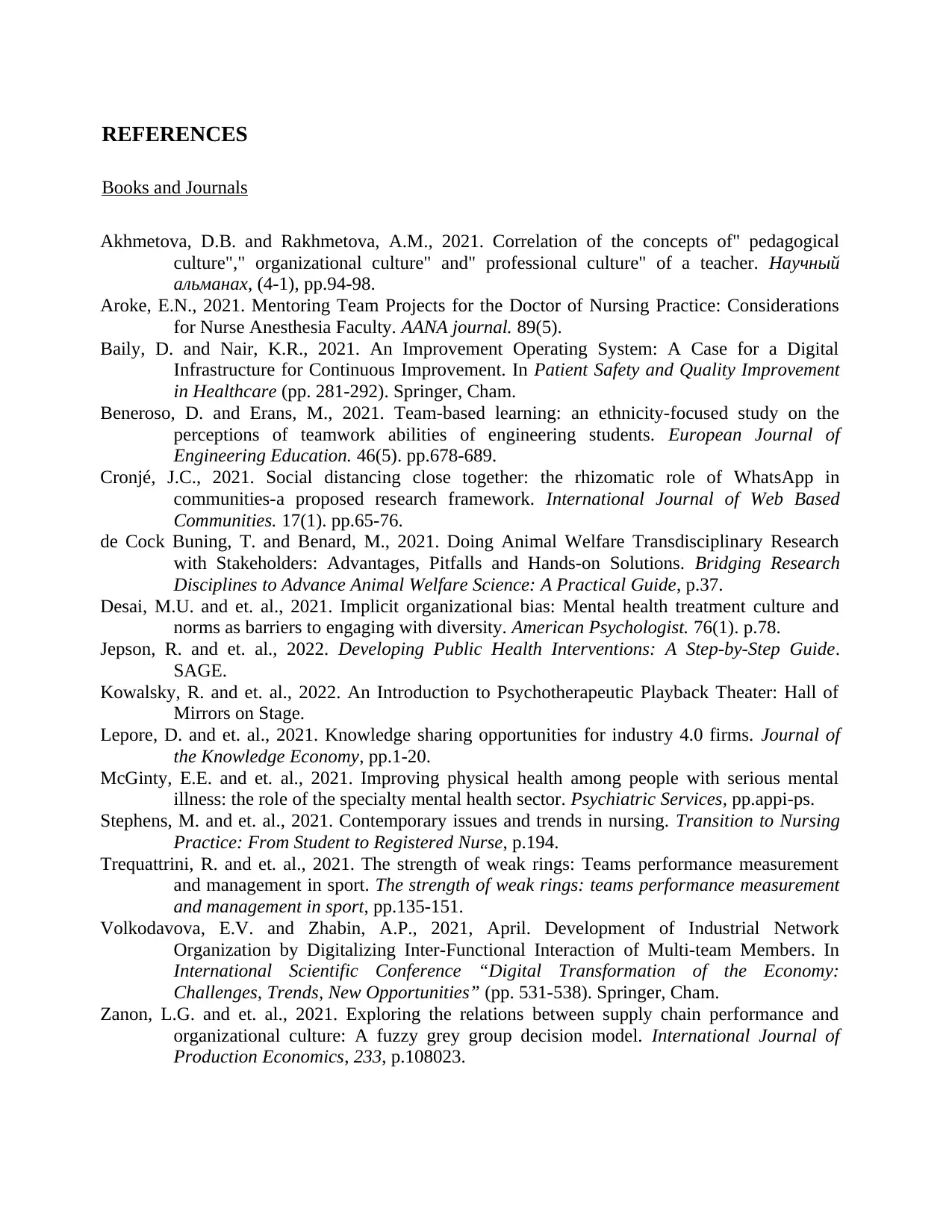
REFERENCES
Books and Journals
Akhmetova, D.B. and Rakhmetova, A.M., 2021. Correlation of the concepts of" pedagogical
culture"," organizational culture" and" professional culture" of a teacher. Научный
альманах, (4-1), pp.94-98.
Aroke, E.N., 2021. Mentoring Team Projects for the Doctor of Nursing Practice: Considerations
for Nurse Anesthesia Faculty. AANA journal. 89(5).
Baily, D. and Nair, K.R., 2021. An Improvement Operating System: A Case for a Digital
Infrastructure for Continuous Improvement. In Patient Safety and Quality Improvement
in Healthcare (pp. 281-292). Springer, Cham.
Beneroso, D. and Erans, M., 2021. Team-based learning: an ethnicity-focused study on the
perceptions of teamwork abilities of engineering students. European Journal of
Engineering Education. 46(5). pp.678-689.
Cronjé, J.C., 2021. Social distancing close together: the rhizomatic role of WhatsApp in
communities-a proposed research framework. International Journal of Web Based
Communities. 17(1). pp.65-76.
de Cock Buning, T. and Benard, M., 2021. Doing Animal Welfare Transdisciplinary Research
with Stakeholders: Advantages, Pitfalls and Hands-on Solutions. Bridging Research
Disciplines to Advance Animal Welfare Science: A Practical Guide, p.37.
Desai, M.U. and et. al., 2021. Implicit organizational bias: Mental health treatment culture and
norms as barriers to engaging with diversity. American Psychologist. 76(1). p.78.
Jepson, R. and et. al., 2022. Developing Public Health Interventions: A Step-by-Step Guide.
SAGE.
Kowalsky, R. and et. al., 2022. An Introduction to Psychotherapeutic Playback Theater: Hall of
Mirrors on Stage.
Lepore, D. and et. al., 2021. Knowledge sharing opportunities for industry 4.0 firms. Journal of
the Knowledge Economy, pp.1-20.
McGinty, E.E. and et. al., 2021. Improving physical health among people with serious mental
illness: the role of the specialty mental health sector. Psychiatric Services, pp.appi-ps.
Stephens, M. and et. al., 2021. Contemporary issues and trends in nursing. Transition to Nursing
Practice: From Student to Registered Nurse, p.194.
Trequattrini, R. and et. al., 2021. The strength of weak rings: Teams performance measurement
and management in sport. The strength of weak rings: teams performance measurement
and management in sport, pp.135-151.
Volkodavova, E.V. and Zhabin, A.P., 2021, April. Development of Industrial Network
Organization by Digitalizing Inter-Functional Interaction of Multi-team Members. In
International Scientific Conference “Digital Transformation of the Economy:
Challenges, Trends, New Opportunities” (pp. 531-538). Springer, Cham.
Zanon, L.G. and et. al., 2021. Exploring the relations between supply chain performance and
organizational culture: A fuzzy grey group decision model. International Journal of
Production Economics, 233, p.108023.
Books and Journals
Akhmetova, D.B. and Rakhmetova, A.M., 2021. Correlation of the concepts of" pedagogical
culture"," organizational culture" and" professional culture" of a teacher. Научный
альманах, (4-1), pp.94-98.
Aroke, E.N., 2021. Mentoring Team Projects for the Doctor of Nursing Practice: Considerations
for Nurse Anesthesia Faculty. AANA journal. 89(5).
Baily, D. and Nair, K.R., 2021. An Improvement Operating System: A Case for a Digital
Infrastructure for Continuous Improvement. In Patient Safety and Quality Improvement
in Healthcare (pp. 281-292). Springer, Cham.
Beneroso, D. and Erans, M., 2021. Team-based learning: an ethnicity-focused study on the
perceptions of teamwork abilities of engineering students. European Journal of
Engineering Education. 46(5). pp.678-689.
Cronjé, J.C., 2021. Social distancing close together: the rhizomatic role of WhatsApp in
communities-a proposed research framework. International Journal of Web Based
Communities. 17(1). pp.65-76.
de Cock Buning, T. and Benard, M., 2021. Doing Animal Welfare Transdisciplinary Research
with Stakeholders: Advantages, Pitfalls and Hands-on Solutions. Bridging Research
Disciplines to Advance Animal Welfare Science: A Practical Guide, p.37.
Desai, M.U. and et. al., 2021. Implicit organizational bias: Mental health treatment culture and
norms as barriers to engaging with diversity. American Psychologist. 76(1). p.78.
Jepson, R. and et. al., 2022. Developing Public Health Interventions: A Step-by-Step Guide.
SAGE.
Kowalsky, R. and et. al., 2022. An Introduction to Psychotherapeutic Playback Theater: Hall of
Mirrors on Stage.
Lepore, D. and et. al., 2021. Knowledge sharing opportunities for industry 4.0 firms. Journal of
the Knowledge Economy, pp.1-20.
McGinty, E.E. and et. al., 2021. Improving physical health among people with serious mental
illness: the role of the specialty mental health sector. Psychiatric Services, pp.appi-ps.
Stephens, M. and et. al., 2021. Contemporary issues and trends in nursing. Transition to Nursing
Practice: From Student to Registered Nurse, p.194.
Trequattrini, R. and et. al., 2021. The strength of weak rings: Teams performance measurement
and management in sport. The strength of weak rings: teams performance measurement
and management in sport, pp.135-151.
Volkodavova, E.V. and Zhabin, A.P., 2021, April. Development of Industrial Network
Organization by Digitalizing Inter-Functional Interaction of Multi-team Members. In
International Scientific Conference “Digital Transformation of the Economy:
Challenges, Trends, New Opportunities” (pp. 531-538). Springer, Cham.
Zanon, L.G. and et. al., 2021. Exploring the relations between supply chain performance and
organizational culture: A fuzzy grey group decision model. International Journal of
Production Economics, 233, p.108023.

⊘ This is a preview!⊘
Do you want full access?
Subscribe today to unlock all pages.

Trusted by 1+ million students worldwide
1 out of 12
Related Documents
Your All-in-One AI-Powered Toolkit for Academic Success.
+13062052269
info@desklib.com
Available 24*7 on WhatsApp / Email
![[object Object]](/_next/static/media/star-bottom.7253800d.svg)
Unlock your academic potential
Copyright © 2020–2025 A2Z Services. All Rights Reserved. Developed and managed by ZUCOL.



